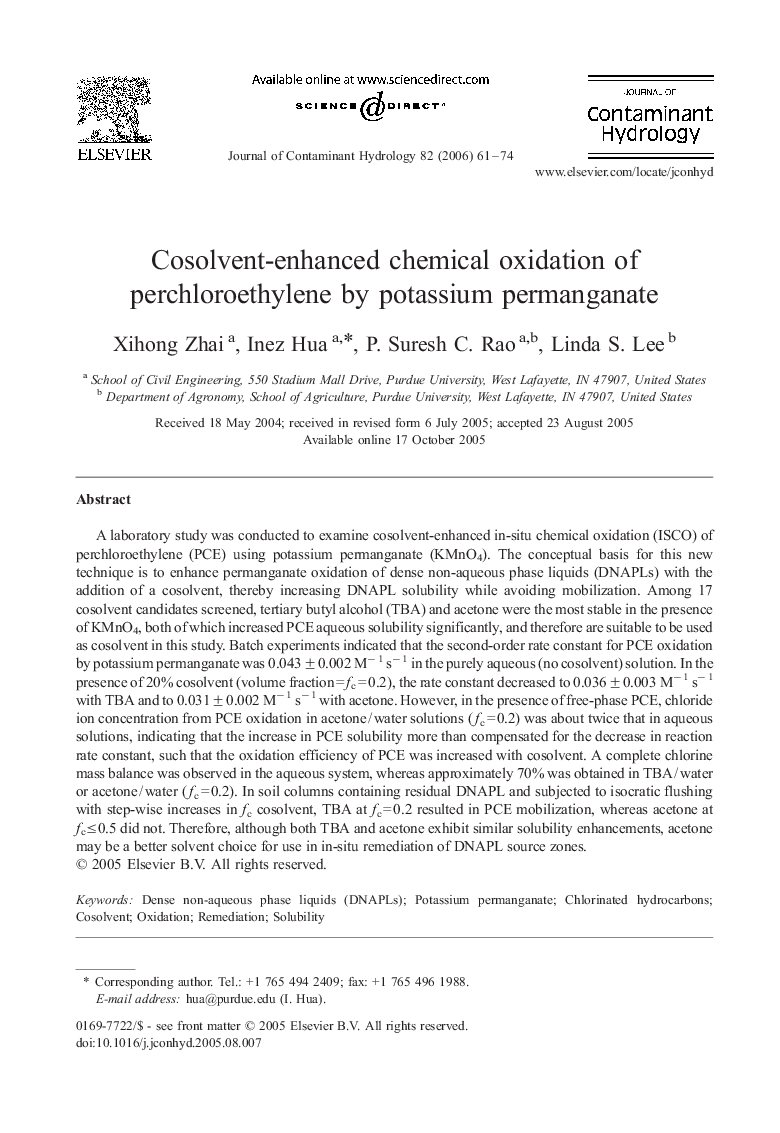| کد مقاله | کد نشریه | سال انتشار | مقاله انگلیسی | نسخه تمام متن |
|---|---|---|---|---|
| 4547784 | 1627143 | 2006 | 14 صفحه PDF | دانلود رایگان |
عنوان انگلیسی مقاله ISI
Cosolvent-enhanced chemical oxidation of perchloroethylene by potassium permanganate
دانلود مقاله + سفارش ترجمه
دانلود مقاله ISI انگلیسی
رایگان برای ایرانیان
کلمات کلیدی
موضوعات مرتبط
مهندسی و علوم پایه
علوم زمین و سیارات
فرآیندهای سطح زمین
پیش نمایش صفحه اول مقاله

چکیده انگلیسی
A laboratory study was conducted to examine cosolvent-enhanced in-situ chemical oxidation (ISCO) of perchloroethylene (PCE) using potassium permanganate (KMnO4). The conceptual basis for this new technique is to enhance permanganate oxidation of dense non-aqueous phase liquids (DNAPLs) with the addition of a cosolvent, thereby increasing DNAPL solubility while avoiding mobilization. Among 17 cosolvent candidates screened, tertiary butyl alcohol (TBA) and acetone were the most stable in the presence of KMnO4, both of which increased PCE aqueous solubility significantly, and therefore are suitable to be used as cosolvent in this study. Batch experiments indicated that the second-order rate constant for PCE oxidation by potassium permanganate was 0.043 ± 0.002 Mâ 1 sâ 1 in the purely aqueous (no cosolvent) solution. In the presence of 20% cosolvent (volume fraction = fc = 0.2), the rate constant decreased to 0.036 ± 0.003 Mâ 1 sâ 1 with TBA and to 0.031 ± 0.002 Mâ 1 sâ 1 with acetone. However, in the presence of free-phase PCE, chloride ion concentration from PCE oxidation in acetone / water solutions (fc = 0.2) was about twice that in aqueous solutions, indicating that the increase in PCE solubility more than compensated for the decrease in reaction rate constant, such that the oxidation efficiency of PCE was increased with cosolvent. A complete chlorine mass balance was observed in the aqueous system, whereas approximately 70% was obtained in TBA / water or acetone / water (fc = 0.2). In soil columns containing residual DNAPL and subjected to isocratic flushing with step-wise increases in fc cosolvent, TBA at fc = 0.2 resulted in PCE mobilization, whereas acetone at fc â¤Â 0.5 did not. Therefore, although both TBA and acetone exhibit similar solubility enhancements, acetone may be a better solvent choice for use in in-situ remediation of DNAPL source zones.
ناشر
Database: Elsevier - ScienceDirect (ساینس دایرکت)
Journal: Journal of Contaminant Hydrology - Volume 82, Issues 1â2, 5 January 2006, Pages 61-74
Journal: Journal of Contaminant Hydrology - Volume 82, Issues 1â2, 5 January 2006, Pages 61-74
نویسندگان
Xihong Zhai, Inez Hua, P. Suresh C. Rao, Linda S. Lee,